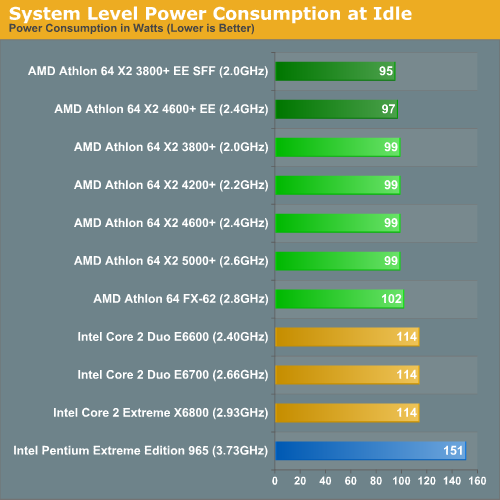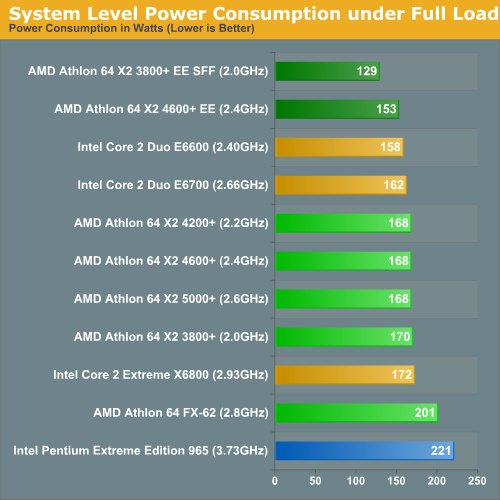Intel's Core 2 Extreme & Core 2 Duo: The Empire Strikes Back
by Anand Lal Shimpi on July 14, 2006 12:00 AM EST- Posted in
- CPUs
Power Consumption: Who is the king?
Intel promised us better performance per watt, lower energy consumed per instruction, and an overall serious reduction in power consumption with Conroe and its Core 2 line of processors. Compared to its NetBurst predecessors, the Core 2 lineup consumes significantly lower power - but what about compared to AMD?
This is one area that AMD is not standing still in, and just days before Intel's launch AMD managed to get us a couple of its long awaited Energy Efficient Athlon 64 X2 processors that are manufactured to target much lower TDPs than its other X2 processors. AMD sent us its Athlon 64 X2 4600+ Energy Efficient processor which carries a 65W TDP compared to 89W for the regular 4600+. The more interesting CPU is its Athlon 64 X2 3800+ Energy Efficient Small Form Factor CPU, which features an extremely low 35W rating. We've also included the 89W Athlon 64 X2s in this comparison, as well as the 125W Athlon 64 FX-62.
Cool 'n Quiet and EIST were enabled for AMD and Intel platforms respectively; power consumption was measured at the wall outlet. We used an ASUS M2NPV-VM for our AM2 platform and ASUS' P5W DH Deluxe for our Core 2 platform, but remember that power consumption will be higher with a SLI chipset on either platform. We used a single GeForce 7900 GTX, but since our power consumption tests were all done at the Windows desktop 3D performance/power consumption never came into play.
We took two power measurements: peak at idle and peak under load while performing our Windows Media Encoder 9 test.

Taking into consideration the fact that we were unable to compare two more similar chipsets (we will take a look back at that once retail Intel nForce 5 products hit the shelves), these power numbers heavily favor Intel. The releative power savings over the Extreme Edition 965 show just how big the jump is, and the ~15% idle power advantage our lower power AMD motherboard has over the Intel solution isn't a huge issue, especially when considering the performance advantage for the realtively small power investment.

When looking at load power, we can very clearly see that AMD is no longer the performance per watt king. While the Energy Efficient (EE) line of X2 processors is clearly very good at dropping load power (especially in the case of the 3800+), not even these chips can compete with the efficiency of the Core 2 line while encoding with WME9. The bottom line is that Intel just gets it done faster while pulling fewer watts (e.g. Performance/Watt on the X6800 is 0.3575 vs. 0.2757 on the X2 3800+ EE SFF).
In fact, in a complete turn around from what we've seen in the past, the highest end Core 2 processor is actually the most efficient (performance per Watt) processor in the lineup for WME9. This time, those who take the plunge on a high priced processor will not be stuck with brute force and a huge electric bill.










202 Comments
View All Comments
Calin - Friday, July 14, 2006 - link
A very good part of what Intel makes (processor wise) goes to mainstream and lower-than-mainstream performance (Celeron-like chips). There might be, in the end (of the year), enough production of Core2 to fill the enthusiast/retail market.Indeed, the Netburst are obsolete over night...
xFlankerx - Friday, July 14, 2006 - link
Not just Netburst, even the Athlon 64s are obsolete now.With the Pentium 4 vs. Athlon 64 debate, atleast there were moments when going with the Pentium 4 could be justified. However, because of the huge difference in performance and prices of the Core 2 Duo and Athlon 64 processors, I think it would be foolish to go for a new Athlon 64 system right now (unless ofcourse you're on a tight budget).
Calin - Friday, July 14, 2006 - link
Yes, Pentium4 was better in so-called media benchmarks, and there were some uber-optimized application that were flying on Pentium4.Right now, there are (as stated in article) three competitors: Core2Duo at high price, performance and low power, Athlon64 X2 at lower price, performance and a bit higher power, and PentiumD at dumping prices, even lower performance and quite a bit higher power. It all depends on how much money you would invest.
I am thinking at a single core Core2, and integrated video mainboard with ATI or NVidia chipset - or a Sempron AM2 3000+. I wonder how cheap a Core2 Solo would be
Squidward - Friday, July 14, 2006 - link
Agreed, an excellent review, I loved Anand's anologies about the dinner table. I get the feeling he may have been thinking Arby's (tm) when he wrote this review. :)My goodness does Intel's new lineup impress. I've been using AMD ever since the K6/2 days and was planning on getting an X2 soon, but this review has made me decide to wait it out just a little bit longer.
Great article guys, keep up the good work.
Viditor - Friday, July 14, 2006 - link
I'd say that the A64 X2s are still quite competitive, depending on your budget and availability of the C2Ds.
That said, Intel has done a magnificent job with these chips!
It looks like Conroe will own the high end market until AMD can release K8L...but judging by the review, AMD will own the low end. I can't see anyone buying a PD once AMD drops the prices, nor can I see anyone buying an AMD if they can afford a medium or higher priced system.
jkostans - Friday, July 14, 2006 - link
With the 1.83GHz conroe at $183 and on par with a X2 4600, I don't see the low end going for AMD either.Ultra low end will be a toss up however.Viditor - Saturday, July 15, 2006 - link
If you look at the situation in total, it will probably make more sense...
1. The X2 has far more inexpensive but fully functional motherboards to choose from.
2. Supply will be far more constrained on the Conroe than on the X2
Combos are king in the low end...for example, if you combine an Asus M2NPV-VM with an AM2 X2 3800 (after the price drop), you get a good dual core system with Raid 5, HDTV, nVidia 6150 graphics, Firewire, dual screen (VGA and DVI), and just about every whistle and bell you could want for (est) ~$250. You'd be hard pressed to find just a Conroe-ready motherboard with that kind of functionality for that kind of money (let alone a combo).
duploxxx - Friday, July 14, 2006 - link
correct the real performance king will be for now the conroe starting from 6600 and above. maybe 6400 this will be clear later. but for the budget platform it will be better to buy an x2 3800 or 4200 seeing the price combo it will have. mobo + proc is way cheaper then any intel combo (100$ and more) thats a lot for a budget system.duploxxx - Friday, July 14, 2006 - link
oh and one big item which is left out of sighht... the performance gain is less on a conroe then on a k8.. its a difference of 15% in identical apps... that's an interesting point for the future... just my opinionXenoid - Friday, July 14, 2006 - link
Yes it was a very, very well done review and I will definitely be purchasing one of these bad boys.